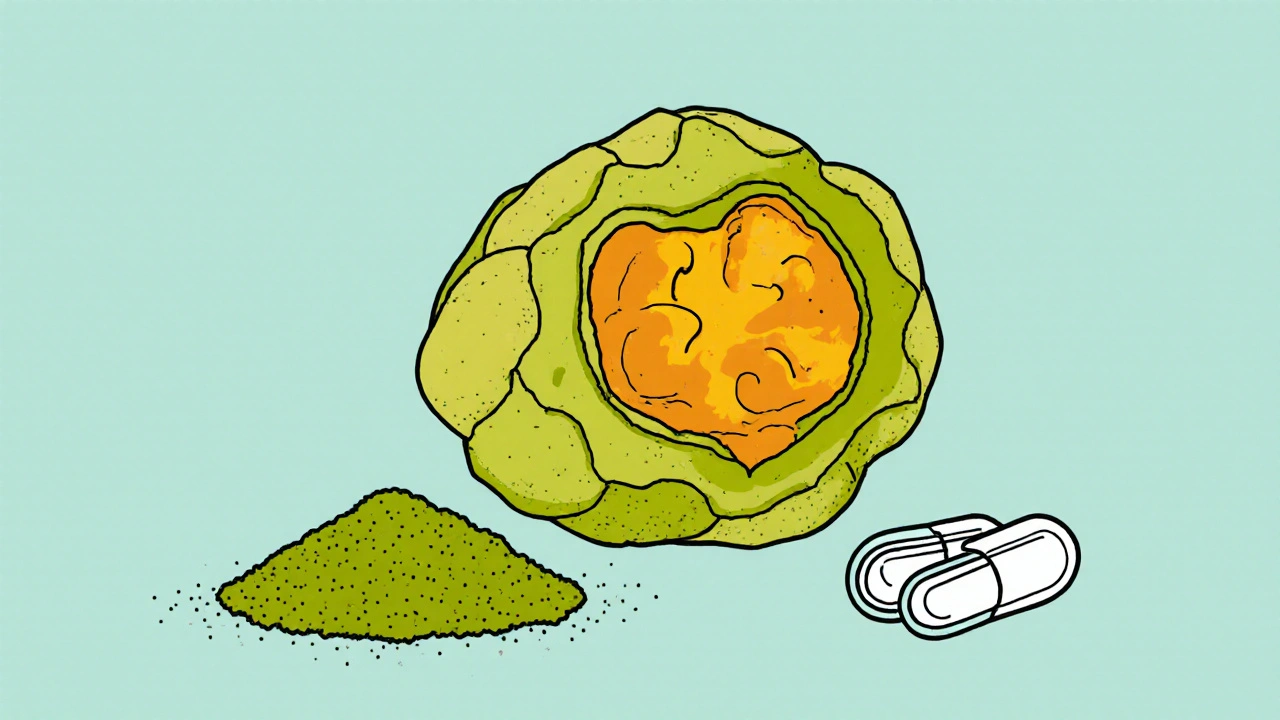
Herbal Antioxidant Selector
Find Your Perfect Herbal Supplement
Select your primary health goal to see the top alternatives ranked by antioxidant strength, cost, and suitability.
What's your main health goal?
Top Recommendations
Looking for a natural boost to immunity, skin health, or antioxidant protection? Amalaki extract often lands on the shortlist, but the market is crowded with other herbal options. This guide breaks down the most popular alternatives, compares their key traits, and helps you decide which one fits your health goals.
What is Amalaki Extract?
Amalaki extract is a concentrated powder derived from the dried fruit of Emblica officinalis, commonly known as Indian gooseberry or amla. The extraction process preserves the fruit’s high vitamin C content (up to 600 mg per gram) and a suite of polyphenols such as gallic acid, ellagic acid, and flavonoids. These compounds give the extract a powerful antioxidant capacity measured at around 50,000 µmol TE per 100 g in ORAC (Oxygen Radical Absorbance Capacity) tests.
Manufacturers typically offer the extract in capsules, tablets, or loose powder, making it easy to incorporate into daily regimens. Because it’s a full-spectrum extract, you get the synergy of the whole fruit rather than isolated nutrients.
How to Pick the Right Herbal Antioxidant
- Potency: Look at ORAC scores or the amount of active compounds per serving.
- Bioavailability: Some extracts are bound to lipids or use patented delivery systems that improve absorption.
- Standardization: A label that specifies a % of key actives (e.g., 30% polyphenols) ensures consistency.
- Safety profile: Check for known side‑effects, contraindications, and third‑party testing.
- Cost per dose: Compare the price you pay for the amount of actives you actually consume.
Popular Alternatives to Amalaki Extract
Below are the most frequently cited herbal competitors. Each offers a different blend of antioxidants, additional adaptogenic benefits, or unique mineral profiles.
- Amla powder - Whole‑fruit dried and ground, often used in Ayurvedic cooking.
- Amla capsules - Pre‑measured doses of standardized amla extract.
- Amla juice - Fresh‑pressed or bottled, contains natural sugars and vitamin C.
- Turmeric extract - Curcumin‑rich, best known for anti‑inflammatory properties.
- Ashwagandha - An adaptogen that modulates stress hormones while offering antioxidant support.
- Guggul - Resin from the Commiphora mukul tree, used for lipid regulation and joint health.
- Neem leaf extract - Antimicrobial and detoxifying, high in flavonoids.
- Vitamin C - Synthetic ascorbic acid, the classic antioxidant but lacks synergistic polyphenols.
Side‑by‑Side Comparison
| Product | Typical Form | Main Active(s) | ORAC (µmol TE/100 g) | Typical Dose | Price per Dose (USD) | Best For |
|---|---|---|---|---|---|---|
| Amalaki extract | Capsule / Powder | Vitamin C, Gallic acid, Ellagic acid | ≈50,000 | 300 mg | $0.25 | Immune boost, skin health |
| Amla powder | Loose powder | Whole‑fruit polyphenols | ≈45,000 | 1 g | $0.15 | Cooking, daily antioxidant |
| Amla capsules | Encapsulated extract | Standardized 30% polyphenols | ≈48,000 | 2 capsules (≈400 mg) | $0.30 | Convenient dosing |
| Amla juice | Liquid | Vitamin C, sugars | ≈35,000 | 100 ml | $0.20 | Hydration + antioxidants |
| Turmeric extract | Capsule / Powder | Curcumin (95%) | ≈22,000 | 500 mg | $0.28 | Joint health, inflammation |
| Ashwagandha | Root powder / Capsule | Withanolides | ≈12,000 | 300 mg | $0.22 | Stress relief, adaptogenic support |
| Guggul | Resin extract | Guggulsterones | ≈8,000 | 250 mg | $0.35 | Cholesterol, joint comfort |
| Neem leaf extract | Powder / Capsule | Azadirachtin, Flavonoids | ≈15,000 | 400 mg | $0.27 | Detox, skin clarity |
| Vitamin C (synthetic) | Tablet / Powder | Ascorbic acid | ≈10,000 | 500 mg | $0.10 | Short‑term immune support |
Deep Dive Into Each Alternative
- Amla powder - Because it’s the whole fruit ground into a fine dust, you retain fiber and a broader phytochemical profile. It works well in smoothies or as a sprinkle on oatmeal. The main downside is a slightly gritty texture.
- Amla capsules - Ideal for people who dislike the taste of raw amla. Look for brands that certify a minimum of 30% polyphenols; otherwise potency can vary widely.
- Amla juice - Provides hydration plus antioxidants but adds natural sugars (~5 g per 100 ml). Choose cold‑pressed, no‑added‑sugar versions to keep it clean.
- Turmeric extract - Curcumin is poorly absorbed on its own, so the best products pair it with piperine (black‑pepper extract) or use a liposomal delivery system. If joint pain is your main concern, turmeric often outperforms amla.
- Ashwagandha - Works more as an adaptogen than a pure antioxidant. It helps lower cortisol, which indirectly reduces oxidative stress. If stress management is a priority, combine it with amla for a two‑pronged approach.
- Guggul - Stronger evidence for lowering LDL cholesterol than for antioxidant effects. It can interact with thyroid medication, so use caution.
- Neem leaf extract - Excellent for skin eruptions and mild detox protocols. The taste is bitter, making it less popular as a daily supplement unless encapsulated.
- Vitamin C (synthetic) - Cheap and proven to raise plasma vitamin C levels quickly. However, it lacks the synergistic flavonoids that help the body recycle the vitamin, so the overall antioxidant impact is lower than whole‑fruit amla.
Which One Is Best for Your Goal?
- Boosting immunity quickly - Amalaki extract or a high‑dose vitamin C tablet. The extract’s additional polyphenols give a longer‑lasting effect.
- Supporting joint health - Turmeric extract with piperine is the clear winner, followed by guggul.
- Managing chronic stress - Pair amla (for its antioxidant shield) with ashwagandha (to lower cortisol).
- Improving skin clarity - Neem leaf extract or amla juice; the juice provides hydration while neem offers antibacterial benefits.
- Budget‑friendly daily antioxidant - Synthetic vitamin C is the cheapest per dose, but amla powder offers better value if you can handle the texture.
Key Takeaways
- Amalaki extract delivers a high antioxidant punch with a full spectrum of vitamin C and polyphenols.
- Standardization matters-look for products guaranteeing at least 30% polyphenols.
- Turmeric excels for inflammation, while ashwagandha shines for stress.
- For skin‑focused regimens, neem and amla juice are complementary.
- Cost per active dose is often lower with bulk powder forms, but capsules win on convenience.
Frequently Asked Questions
Is Amalaki extract safe for daily use?
Yes, most healthy adults can take 300‑500 mg per day without side effects. People on blood‑thinning medication should monitor dosage, as the high vitamin C can increase iron absorption.
How does Amalaki compare to synthetic vitamin C?
Synthetic vitamin C provides a single antioxidant molecule, while Amalaki brings vitamin C plus a bundle of flavonoids that help recycle the vitamin and extend its protective effect.
Can I mix Amalaki extract with other herbs?
Mixing is fine. A popular stack is Amalaki + Ashwagandha for immune‑stress support, or Amalaki + Turmeric for a combined antioxidant‑anti‑inflammatory blend. Keep total dosage of each herb within recommended ranges.
What’s the best form for people with digestion issues?
Capsules with a liposomal coating are gentle on the stomach and improve absorption. If you prefer a powder, mix it with a smoothie that contains healthy fats to aid uptake.
Is there a difference between Indian‑grown and overseas Amalaki?
Soil quality and climate affect polyphenol levels. Indian‑grown fruit, especially from the Himalayan foothills, tends to have higher ORAC scores, but reputable suppliers worldwide now use standardized extraction to ensure consistency.




13 Comments
Amalaki extract is a powerhouse when it comes to natural antioxidants, and it’s worth understanding why. The vitamin C content alone can easily rival a glass of orange juice, but the real advantage lies in the polyphenol mix. Gallic acid, ellagic acid, and a host of flavonoids work together to neutralize free radicals more efficiently than isolated compounds. Because the extract is full‑spectrum, you also get the fiber‑bound nutrients that help with slow release and better absorption. When you compare the ORAC score of about 50,000 µmol TE per 100 g to turmeric’s roughly 22,000, the gap is significant. That said, turmeric shines in the anti‑inflammatory department thanks to curcumin, especially when paired with piperine. If joint health is your primary goal, a turmeric‑piperine combo will outperform amla for reducing stiffness. For immune support, the synergy of vitamin C and polyphenols in amla offers a longer‑lasting effect than a single‑dose vitamin C tablet. The price per dose of amla extract is modest, typically around a quarter of a dollar, which makes it accessible for daily use. Standardized products that guarantee at least 30 % polyphenols are the ones you should look for, because potency can vary wildly. Capsules with a liposomal coating can improve bioavailability if you have a sensitive stomach. If you prefer a culinary approach, amla powder can be blended into smoothies, oatmeal, or even chutneys for a fiber boost. The powder does have a gritty texture, but that’s the trade‑off for retaining the whole‑fruit matrix. For those who dislike the taste, capsules or a cold‑pressed amla juice provide a convenient alternative. Keep an eye on interactions; high vitamin C can increase iron absorption, which matters if you’re on blood‑thinners. In short, amla extract is a versatile, high‑ORAC herb that fits well into most antioxidant stacks, especially when paired with adaptogens like ashwagandha or anti‑inflammatories like turmeric.
Sounds like a solid plan 😊
I’ve seen a lot of people struggle to pick the right form of amla, and the best advice is to match the supplement to your lifestyle. If you already blend smoothies every morning, the loose powder slips in without a fuss. For busy folks, the pre‑measured capsules save time and guarantee consistency. Either way, you’re still getting that robust antioxidant shield.
Big pharma and supplement conglomerates love to hide the real potency numbers behind vague labels, so you have to dig into third‑party lab reports. Trust only brands that publish full batch analyses, otherwise you might be buying filler.
I’m sure the ‘all‑natural’ badge guarantees zero side‑effects, right? In reality, taking more than 1 g of amla powder can upset a delicate stomach, especially on an empty belly. So, moderation is still the golden rule.
Let’s be crystal clear: the most bioactive amla comes from the Himalayan foothills, not some generic farm in Southeast Asia. The terroir, altitude, and indigenous soil microbiome crank up the polyphenol profile by at least 20 %. If you’re serious about peak antioxidant performance, demand Indian‑sourced, GMP‑certified extracts – no compromises.
Absolutely love that you’re diving into the herb world – it’s like a mini‑adventure for your health 🌱. Remember, consistency beats intensity, so stick to your daily dose like a champ 😎. If you ever feel the texture is off, just blend it into a banana shake and call it a ‘protein‑plus’ snack 🍌. And hey, if the market tries to sell you cheap fillers, just give them the side‑eye and move on 🙄.
Curious about stacking amla with ashwagandha? The combo hits both oxidative stress and cortisol, giving you a two‑pronged shield that’s hard to beat. Just keep the total herb load under 1 g per day to avoid gut overload, and you’ll notice steadier energy within a week.
Great breakdown-ORAC values, bioavailability, cost per dose-all essential metrics, and the comparative matrix nails the decision‑making process.
We cannot ignore the centuries‑old wisdom embedded in Ayurvedic texts that champion amla as the ‘queen of fruits.’ Modern science is finally catching up, confirming what Indian sages knew: the synergistic blend of vitamin C and polyphenols offers unrivaled immune fortification. Yet the global supplement market keeps diluting this gem with sub‑par extracts, jeopardizing public health. It’s high time consumers demand authenticity, traceability, and rigorous testing from manufacturers. Only then can we preserve the true legacy of our heritage herbs.
In the grand tapestry of wellness, each herb is a thread that adds color to our personal narrative. Choosing amla or its counterparts is less about competition and more about harmonious balance within our bodies and cultures. May your supplement journey be guided by curiosity, respect, and the joy of discovery.
If you think you’ve seen the highest ORAC score, think again – amla extract can literally blow your mind with its antioxidant firepower. Trust me, I’ve read every study, and the sheer enthusiasm of the data is just *wow*.
Thank you all for the insightful contributions; the comparative analysis presented herein will undoubtedly assist readers in making informed decisions. Should further clarification be required, I remain at your disposal.